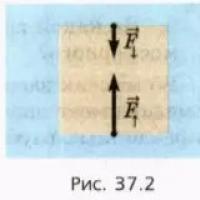Mass of brickwork. Weight of brickwork, how much does a cube of brickwork weigh? Weight of 1 m3 of brickwork
Brick is usually called a wall material that is obtained by firing different types of raw materials. For ceramics, these are certain types of clay, and for silicate products, sand, lime and water. Each of the considered types of wall products has its own characteristics, which means their weight per unit volume (in our case, a cubic meter) will not be the same.
The weight of each individual brick will depend not only on the raw material composition, this indicator is also influenced by production technology (firing temperature, presence of voids, etc.). It should be noted that each wall material has its own tolerances for individual characteristics, including weight.
First, let's look at ceramic bricks. As we have already said, the raw materials for its production are clay and water. The finished product has high strength characteristics, the ability to retain heat and resistance to external aggressive environments. The weight of one unit of standard size brick ranges from 3.4-3.8 kilograms. To improve the thermal insulation properties, as well as reduce the weight of an individual specimen, manufacturers began to produce porous bricks weighing about 2.5 kilograms.
The density of the material is significantly influenced by its structure, as well as its purpose. For example, an indicator such as specific gravity will be equal for all types of ceramics, because such a characteristic indicates the value of the mass of the material without voids.
Solid ceramic brick
A solid brick for laying walls will have more mass than a porous or hollow counterpart. Now let’s look at the main indicators of the weight of solid ceramic bricks:
- for red single brick 1650-1850 kg/m 3;
- one-and-a-half clay brick has a weight of 1500-1600 kg/m 3;
- double ceramic brick – 1600-1750 kg/m3;
Hollow Ceramic Brick
The weight of a brick with voids will depend on its overall dimensions and the volume fraction of the cracks; it has the following values:
- single ordinary brick - 1200-1280 kg/m 3;
- one-and-a-half clay brick - 1130-1260 kg/m 3;
- the weight of one and a half bricks ranges from 970 to 1200 kg/m 3.
The lightest hollow brick is considered to be a facing hollow brick, which allows reducing the load on the foundation: a single brick weighs 650-820 kg/m3, and a one-and-a-half brick weighs 1000-1620 kg/m3.
Weight of sand-lime brick in 1 m 3
The maximum weight has silicate brick, which is made from quartz sand, lime and water purified from harmful impurities. This material has a good level of sound insulation and a long service life. The products in question are usually used for laying load-bearing walls and finishing facades. A solid brick weighs at least 3.7 kilograms, while a hollow brick weighs only 3.2 kilograms. The mass of ordinary solid materials is as follows:
- single – 1600-1700 kg/m3;
- one and a half - 1400-1500 kg/m 3;
- double – 1300 kg/m3.
If we consider the mass of silicate slotted brick, it is as follows: for single 1400-1500 kg/m 3, for double – 1100-1200 kg/m 3.
The weight of a brick per cubic meter can be calculated independently, knowing the mass of an individual product and the quantity per given volume. For example, in a cubic meter of solid sand-lime brick there are 500 pieces (notional quantity), and the average weight of the product is 4 kilograms. In this case, the density indicator will be 500 × 4 = 2000 kg/m 3.
How much does 1 cube of brickwork weigh, the weight of 1 m3 of brickwork. The number of kilograms in 1 cubic meter of a brick wall, the number of tons in 1 cubic meter of a brick wall, kg in 1 m3 of a brick wall. Volumetric density of brickwork and specific gravity of a brick wall.What do we want to learn today? How much does 1 cube of brickwork weigh, what is the weight of 1 m3 of brickwork? No problem, you can find out the number of kilograms or the number of tons at once, the mass (weight of one cubic meter, weight of one cube, weight of one cubic meter, weight of 1 m3) is indicated in Table 1. If anyone is interested, you can skim the small text below and read some explanations. How is the amount of substance, material, liquid or gas we need measured? Except for those cases when it is possible to reduce the calculation of the required quantity to the counting of goods, products, elements in pieces (piece counting), it is easiest for us to determine the required quantity based on volume and weight (mass). In everyday life, the most common unit of volume measurement for us is 1 liter. However, the number of liters suitable for household calculations is not always an appropriate way to determine the volume for business activities. In addition, liters in our country have not become a generally accepted “production” and trade unit for measuring volume. One cubic meter, or in its abbreviated version - one cube, turned out to be a fairly convenient and popular unit of volume for practical use. We are accustomed to measuring almost all substances, liquids, materials and even gases in cubic meters. It's really convenient. After all, their costs, prices, rates, consumption rates, tariffs, supply contracts are almost always tied to cubic meters (cubes), and much less often to liters. No less important for practical activities is knowledge of not only the volume, but also the weight (mass) of the substance occupying this volume: in this case we are talking about how much 1 cubic meter weighs (1 cubic meter, 1 cubic meter, 1 m3). Knowing mass and volume gives us a fairly complete idea of quantity. Site visitors, when asking how much 1 cube weighs, often indicate specific units of mass in which they would like to know the answer to the question. As we noticed, most often they want to know the weight of 1 cube (1 cubic meter, 1 cubic meter, 1 m3) in kilograms (kg) or tons (t). Essentially, you need kg/m3 or t/m3. These are closely related units that define quantity. In principle, a fairly simple independent conversion of weight (mass) from tons to kilograms and vice versa is possible: from kilograms to tons. However, as practice has shown, for most site visitors a more convenient option would be to immediately find out how many kilograms 1 cubic (1 m3) of brickwork weighs or how many tons 1 cubic (1 m3) of brickwork weighs, without converting kilograms into tons or vice versa - quantities tons to kilograms per cubic meter (one cubic meter, one cubic meter, one m3). Therefore, in Table 1 we indicated how much 1 cubic meter (1 cubic meter, 1 cubic meter) weighs in kilograms (kg) and tons (t). Choose the table column that you need yourself. By the way, when we ask how much 1 cube (1 m3) weighs, we mean mass - the number of kilograms or the number of tons. However, from a physical point of view, we are interested in density or specific gravity. The mass of a unit volume or the amount of substance contained in a unit volume is bulk density or specific gravity. In this case bulk density and specific gravity of brickwork. Density and specific gravity in physics are usually measured not in kg/m3 or tons/m3, but in grams per cubic centimeter: g/cm3. Therefore, in Table 1, specific gravity and density (synonyms) are indicated in grams per cubic centimeter (g/cm3)
Table 1. How much does 1 cube of brickwork weigh, the weight of 1 m3 of brickwork. Bulk density of a brick wall and specific gravity in g/cm3. How many kilograms are in a cube of a brick wall, tons in 1 cubic meter, kg in 1 cubic meter of a brick wall, tons in 1 m3. Additionally, how much: 1 liter weighs, 1 bucket weighs, liters in one cube of a brick wall.
The strength and performance characteristics of a building depend on the building materials used, the size and shape of the structures. The standard weight of brickwork with a volume of 1 m3 must be known to accurately calculate the parameters of the foundation, load-bearing walls and partitions.
Important! An attempt to excessively strengthen building elements only leads to increased loads and excessive consumption of building materials.
The estimated weight of 1m3 of brickwork is determined in accordance with the manufacturer's data, taking into account tolerances. During production, deviations from the technological process inevitably occur in terms of processing modes or raw materials used.
These fluctuations must fit within a certain interval, which is called tolerance. Thus, the total weight of the masonry can fluctuate within certain limits.
The connecting link between the individual bricks is cement mortar. This mass should not be neglected, and it may have deviations in one direction or another. Here you should take into account both the thickness and density of the connecting part, which in turn depends on various factors.
Dimensional and weight characteristics of building materials
Building bricks are made from different types of raw materials - it can be clay or sand. Raw materials have different indicators and different technological methods are used in production. The combination of these factors determines the parameters of brick, which is one of the most common materials used in construction.
An overview of its different types is the subject of this article.

Ordinary clay brick
This building material has a long history; at first it was simply sculpted from clay with or without fillers. The dried blocks were immediately used, their strength was low, as was their price, they quickly collapsed under the influence of water and sunlight.
Modern technology involves firing bricks in special kilns and at a certain temperature. Please pay attention to its main technical and operational characteristics:
- the weight of 1 m3 of brickwork ranges from 1.7 to 1.9 tons;
- the thermal conductivity coefficient ranges from 0.65 to 0.7, which in practice means a change in temperature on external surfaces per unit time;
- the coefficient of maximum water absorption should not exceed 8%, which is only possible if there is a porous structure;
- the brand of brick is determined by its strength and compression resistance, has a numerical designation from 75 to 200;
- An important characteristic is frost resistance, determined by the cyclic method; for high-quality material this indicator is 15 freezing and thawing periods.
Many properties of brick depend on the correctly selected firing mode; for the one described, it involves heating to a temperature of 1000 °C with permissible fluctuation in 100 °C in one direction or another.

Silicate brick
Its production began in the 19th century; in our country this material began to be used in the last century. For its production the following types of raw materials are used:
- quarry sand, sifted to remove impurities with certain characteristics;
- quicklime;
- technical prepared water;
- special additives and additives to increase the strength of blocks.
Currently, double sand-lime brick M 150, which has improved characteristics, is in great demand. Its manufacturing technology is as follows:
- a mixture is prepared from quartz sand, burnt lime, technical water, dyes and modifiers in the proportions prescribed by the technological map;
- the composition is molded and placed in an autoclave, in which a special temperature and humidity regime is maintained;
- The finished product is exposed to high pressure, which allows the material to be compacted.

One of the common materials for the construction of walls (partitions) is brick.
When carrying out construction work, it is imperative to take into account the specific gravity of the brickwork to calculate the load effects on the foundation.
Loads must always be taken into account. The integrity of the original building and the safety of the premises as a whole largely depend on this.
Masonry made of silicate, red brick
 The mass of red brick varies from 3.5 to 3.8 kg
The mass of red brick varies from 3.5 to 3.8 kg During construction, red (aka ceramic) or silicate (white) types are used. The first one is based on clay, the second one is lime and sand. They are available in different sizes and shapes. It turns out that 1 m3 of brickwork will contain an unequal number of units of this building material. Accordingly, the mass will differ.
The production of red brick from different types of clay is carried out by firing it in special kilns. With high strength, it has good thermal insulation properties. The weight of one of its pieces ranges from 3.5-3.8 kg.
 Sand-lime brick is heavier than red
Sand-lime brick is heavier than red To reduce it, manufacturers produce a hollow version weighing an average of 2.5 kg per unit. Due to the presence of cavities, a more voluminous hollow one will weigh the same as a full-bodied one.
The heavy silicate version has good thermal insulation properties. It is more durable than red. At the same time, a full-bodied one weighs on average 3.7 kg, and for a hollow one it’s 3.2 kg. The mass characteristics of the more voluminous version are comparable to the full-bodied type.
According to the functions performed, the following are distinguished:
- workers;
- facing.
Calculations
 One cubic meter of mortar is enough for a cubic meter of brick
One cubic meter of mortar is enough for a cubic meter of brick It is necessary to calculate the amount of brick needed when performing work by calculating the volume of the final structure. Based on it, purchase working material.
Everything is not limited to the weight of the bricks: the thickness and number of connecting seams and the characteristics of the bonding mortar are additionally taken into account. To fill voids, more mortar is used than for a solid type.
When performing calculations, it is advisable to focus on measuring the mass indicator of a cubic meter of masonry. For more information on brickwork calculations, watch this useful video:
During construction, one cube of mortar can lay out up to 4 cubes of brick. The specific average weight of the masonry ranges from 1500 to 2000 kg/m3.
In order not to independently calculate the weight of the full brickwork of 1 m3, it is advisable to use the table.
The weight of the brickwork is an important indicator and is calculated at the design stage. The strength and type of the future foundation, as well as the design solutions and architecture of the building, entirely depend on how heavy the load-bearing walls of the structure are.



The need to determine mass
It is necessary to know exactly the weight of one cubic meter of brickwork for many reasons. First of all, this is, of course, the calculation of the maximum permissible load on the foundation and floors. Brick is considered a rather heavy building material, so in order to use it for the construction of capital walls, it is necessary to clearly correlate the permitted load and the specific gravity of the brick. Often the limitation for the use of bricks, especially silicate and hyper-pressed solid models, is the type of soil. Thus, it is not recommended to use brickwork on loose and moving soils. In such cases, you should use alternative materials: expanded clay concrete blocks, foam concrete, gas silicate material or cinder blocks.
Knowing the exact weight of one cubic meter. m of brickwork, you can calculate not only the strength of the foundation, but also to determine the safety margin of each section of the load-bearing wall. This is especially important for calculating the load on the lower and basement floors, as well as for choosing the grade of cement mortar and reinforcing structural elements. In addition, accurate knowledge of the mass of the brickwork allows you to calculate the required carrying capacity of the vehicle that will be used to transport construction waste during the dismantling of structures and dismantling walls.



What affects weight?
The mass of the masonry is primarily influenced by the material used to make the brick. The lightest ceramic products are those made using clay and plasticizers. The products are molded using a special press and then sent to the kiln for firing. Silicate and hyper-pressed products are slightly heavier. To make the former, lime and quartz sand are used, while the latter is based on cement. Clinker models are also quite heavy and are made from types of refractory clay followed by firing at very high temperatures.
In addition to the material of manufacture, the type of brick made has a huge impact on the weight of a square meter of masonry. Based on this characteristic, two large groups of products are distinguished: solid and hollow models. The first are monolithic products of regular shape, without shaped holes or internal cavities. Solid stones weigh on average 30% heavier than their hollow counterparts. However, this material has high thermal conductivity and is rarely used for the construction of load-bearing walls. This is due to the absence of an air layer in the body of the brick and its inability to prevent heat loss from the premises during the cold period.



Hollow models are distinguished by higher performance characteristics and lower weight, which allows them to be most actively used in the construction of external walls. Another factor influencing the mass of brickwork is the porosity of the brick. The more internal cavities a product has, the higher its thermal insulation qualities and the lower its weight. To increase the porosity of ceramic models, sawdust or straw are added to the raw materials at the production stage, which burn out during the firing process and leave behind a large number of small air voids. This allows for the same volume of material to significantly reduce its weight.


In addition, the weight of the cement mortar and metal reinforcement has a huge impact on the mass of the masonry. The first factor largely depends on the professionalism of the mason, as well as on how thick he applies the mortar. The mass of reinforcing elements depends on the number and type of metal structures required to give the building walls increased strength and seismic resistance. It often happens that the total mass of cement mortar and reinforcing mesh is almost equal to the net weight of the brick.
Calculation rules
Before you begin calculating the mass of brickwork, you should familiarize yourself with some terms. There is a specific and volumetric weight of brick. Specific gravity is determined by the ratio of weight to occupied volume and is calculated according to the following formula: Y=P*G, where P is the density of the brick, and G denotes a constant value equal to 9.81. The specific gravity of a brick is measured in newtons per cubic meter and is designated as N/m3. To convert the resulting numbers to the SI system, they must be multiplied by a factor of 0.102. Thus, with an average weight of solid models of 4 kg, the specific gravity of the masonry will vary from 1400 to 1990 kg/m3.
Another important parameter is volumetric weight, which, unlike specific weight, takes into account the presence of cavities and voids. This value is used to determine the mass not of each brick individually, but of a whole cubic meter of products at once. It is the volumetric weight of the products that serves as an indicative value and is taken into account when calculating the mass of brickwork directly during construction.


Knowing the weight of one brick and the number of bricks in one cubic meter of masonry, you can easily calculate how much the entire masonry weighs. To do this, it is enough to multiply both numbers and add the mass of cement mortar to the resulting value. Thus, 513 solid single silicate products of standard size 250x120x65 mm fit in one cubic meter, and the weight of one brick is 3.7 kg. Consequently, one cube of masonry will weigh 1898 kg without taking into account the weight of the mortar. Sesquisilicates already weigh about 4.8 kg per piece, and their number per cubic meter of masonry reaches 379 pieces. Accordingly, masonry of this volume will weigh 1819 kg, also without taking into account the mass of cement.
 What documents are evidence that the apartment is a service apartment?
What documents are evidence that the apartment is a service apartment? Space donut hole
Space donut hole Types of discounts on Russian Railways tickets and rules for obtaining them Train tickets for students
Types of discounts on Russian Railways tickets and rules for obtaining them Train tickets for students Lecture on syndromic pathology
Lecture on syndromic pathology Organizational aspects of the activities of pharmacy organizations
Organizational aspects of the activities of pharmacy organizations Water pressure in the depths of the ocean Practice reports
Water pressure in the depths of the ocean Practice reports What is inductance, its definition and unit of measurement
What is inductance, its definition and unit of measurement